EC-MS Technology
LEARN ABOUT EC-MS TECHNOLOGY AND ITS MANY ADVANTAGES
ABOUT OUR TECHNOLOGY
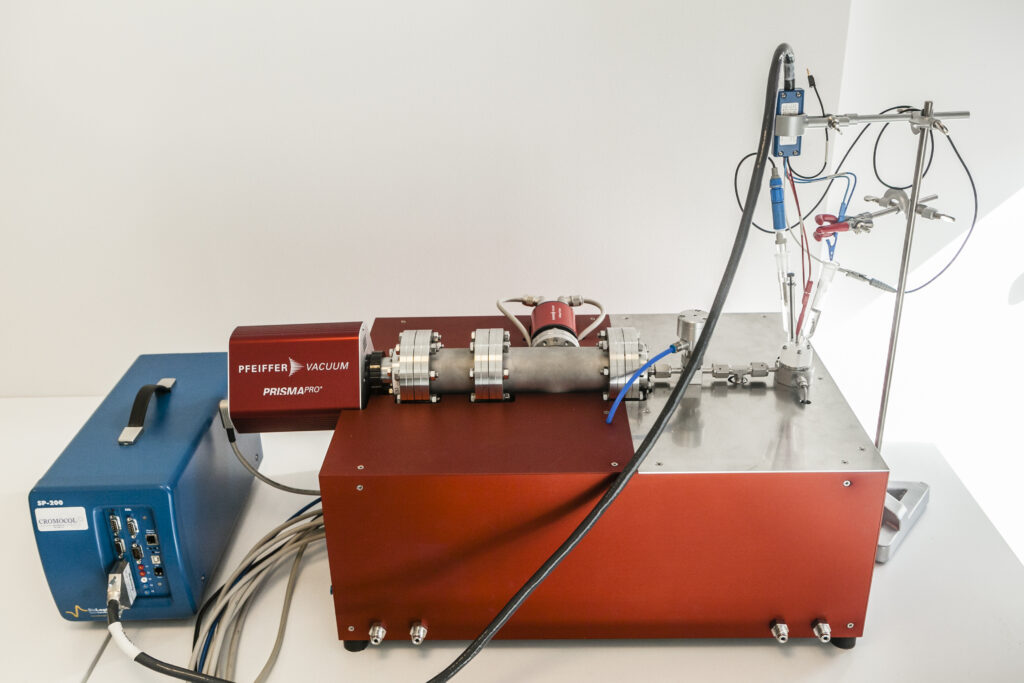
The Spectro inlets EC-MS system is a unique instrument for high-sensitivity time-resolved detection of volatile electrochemistry products directly from a liquid electrolyte. Notably, this instrument is optimized for half-cell investigations, i.e., it allows the user to decouple the evolution of volatile products and consumption of reactants at the working and counter electrodes during electrochemical reactions.
The image shows that the compact instrument fits comfortably on standard laboratory tables. Moreover, it operates straight out of the package upon installation with the embedded, fully functional 3-electrode EC cell and Bio-Logic SP-200 potentiostat.
WORKING PRINCIPLE OF THE MEMBRANE CHIP
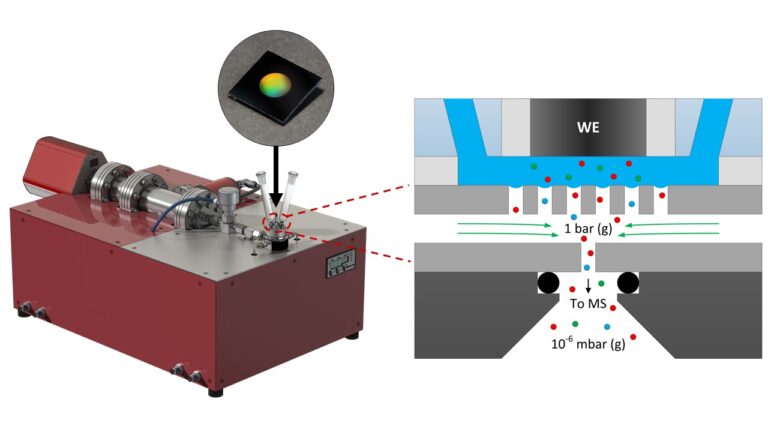
The chip is placed inside the interface block, on top of which the EC-cell is coupled. In the cartoon, the equilibration of volatile analytes between electrolyte and sampling volume is shown.
The membrane chip creates a direct coupling between the electrolyte and the high vacuum of a mass spectrometer (MS) without differential pumping.
The membrane chip creates a well-defined liquid-gas-vacuum interface and controls the transfer of volatile molecules from the electrolyte to the mass spectrometer. Inside the chip, a buried sampling volume equilibrates to the outer environment without letting liquid in. The pressure in the sampling volume is precisely controlled by our embedded gas handling system.
STANDARDIZED SAMPLE HOLDER
The Spectro Inlets EC-MS system is provided with a tailored electrochemistry cell. In collaboration with Pine Research Instruments, we developed the cell and made it compatible with their standard 5 mm cylindrical electrodes used for RDE measurements. Most metals and glassy carbon supports are readily available off the shelf in this standard electrode format, so the user does not need to waste time and money manufacturing custom electrodes. Our EC-cell is manufactured in PCTFE to make it chemically inert and cleanable even with the harshest methods, e.g., piranha solution.
from Pine Research used to retain the working
electrode in the EC cell.
The cell is coupled to glass cylinders made with a conical ground glass joint, a glass frit, and a Luer connector at the bottom to connect a reference and a counter electrode. Such glass connectors are designed to fit, e.g., an Ag/AgCl reference electrode B 3420+ from SI analytics. Any other reference electrode can be used as well.
Mounting and removing the EC cell can be carried out in seconds, valid for working electrode exchange. This allows users to maximize productivity as several experiments can be performed in a very short time. For example, a full activity volcano plot can be measured within one day.
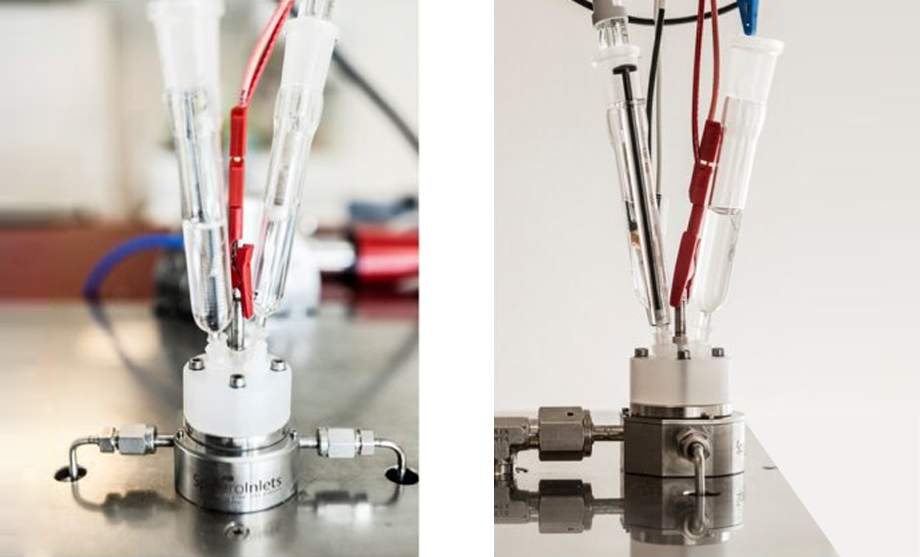
Photographs of the EC cell equipped with a B 3420+ Ag/AgCl electrode, a coiled Pt wire as the counter electrode, and a gas-tight syringe to inject electrolyte into the cell.
Because of the extraordinary control of experimental parameters obtained by microchip design, the transport mechanisms of species from the electrode surface through the electrolyte and to the sampling volume are fully defined and modeled
(Trimarco et al. Electrochim. Acta).
The thin-layer cell is designed to transfer and quantify all volatile molecules that evolve at the electrode surface to the mass spectrometer. This is a truly unique characteristic of the Spectro Inlets system, and it allows to obtain, e.g., the data shown in CO-stripping.
The cell can also be operated in flow mode.
FAST TIME RESPONSE
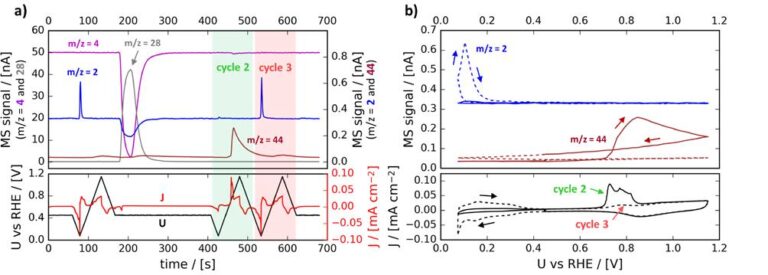
Figure 1.
H2 evolution and CO stripping experiments using a 5 mm polycrystalline Pt electrode in 1M HClO4. Potential sweeps are carried out at 20 mV/s. a) Different signals from the mass spectrometer corresponding to H2 (m/z=2), He (m/z=4), CO (m/z=28), and CO2 (m/z=44) along with the potential and current density as a function of time. b) MS signal as a function of applied voltage and CVs corresponding to the colored sweeps in a).
The system can measure composition changes of volatile species with a time resolution down to 0.1 seconds. This allows for producing EC-MS plots effortlessly, as shown in Figure 1, with EC and MS signals plotted against time (a) and applied potential (b).
The software integration takes care of synchronization, so there is no need to manually (and somewhat inaccurately) record the time-zero when the EC technique is started with respect to the MS signal. For more information on software integration, see the software section below.
D. B. Trimarco et al., Enabling real-time detection of electrochemical desorption phenomena with sub-monolayer sensitivity. Electrochim. Acta. 268, 520–530 (2018).
HIGH SENSITIVITY AND DYNAMIC RANGE
The chip is the secret behind the ultra-high sensitivity that allows the Spectro Inlets system to detect down to 10 ppm of a monolayer desorbing in a second. By design, the membrane chip is 3-4 orders of magnitude more sensitive than conventional Differential Electrochemical Mass Spectrometer – DEMS systems for light substances.
The membrane chip was chosen to optimize the collection efficiency for molecules with high volatility and those which occur most often in electrochemical experiments while lowering the uninteresting water signal. Any volatile can be measured, with a response time depending on the analyte’s solubility, volatility, and stickiness.
With the Spectro Inlets system, you can measure continuous product formation from 1 mA to 1 nA. We have collaborated with Pfeiffer Vacuum to bring you the ideal mass spectrometer for EC-MS measurements, enabling the extraordinary sensitivity that the Spectro Inlets EC-MS system guarantees.
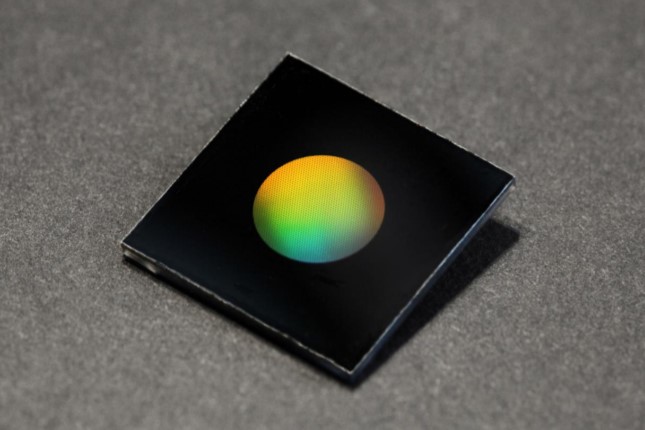
With a 7-orders-of-magnitude dynamic range, the Spectro Inlets system can operate with gases with a 6.0 purity level. Furthermore, the entire system is constructed using VCR® metal gasket face seal components, rated for ultrahigh vacuum applications, and compatible with 6.0 gases.
QUANTITATIVE ANALYSIS

The Spectro Inlets system goes beyond bare detection of volatiles in liquids as it enables true real-time quantification of reaction product formation. This means the difference between just measuring relative amounts of substances and literally counting the molecules desorbing from an electrode surface due to an electrochemical event. This allows to study half-cell transient phenomena and get true mechanistic insight and fundamental understanding.
Quantitative analysis is enabled by the microchip geometry, in synergy with the embedded gas and vacuum systems. Because the chip is designed to deliver precisely 1015 molecules/s and the system can collect all the molecules transferred to the mass spectrometer, data can be calibrated directly to mol/s.
DOSING OF REACTANT GASES
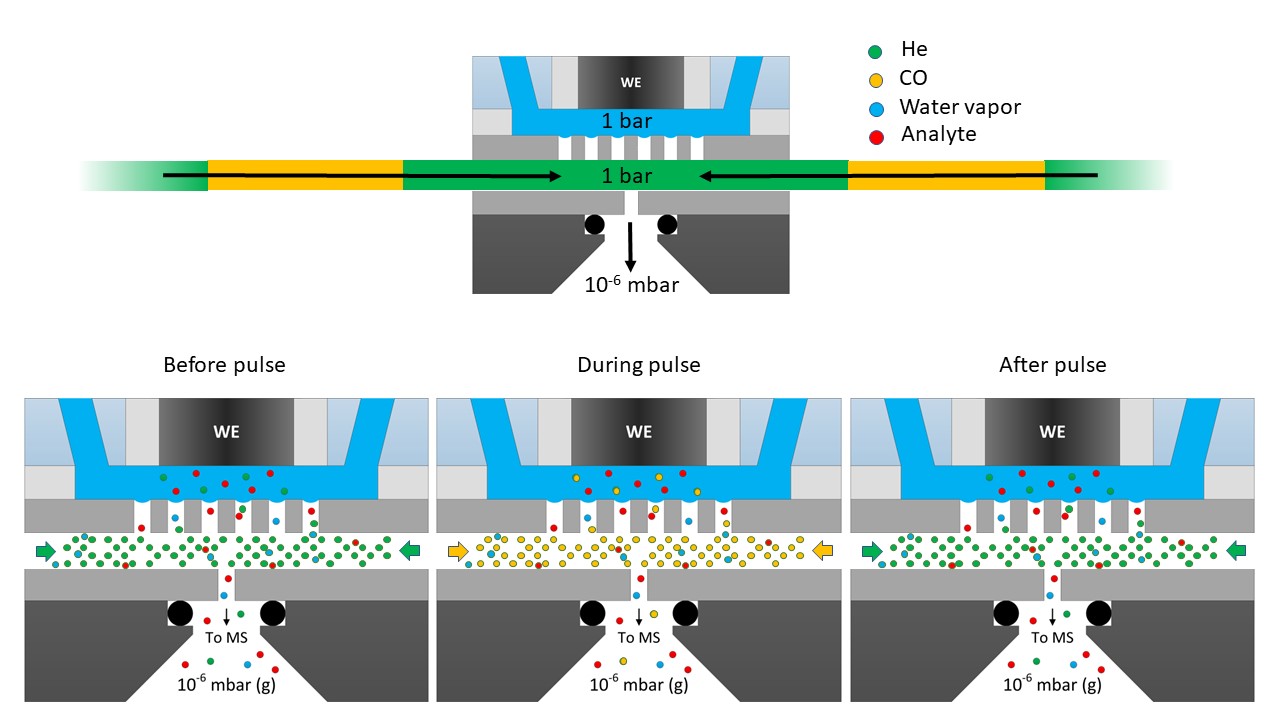
Figure 6. Schematic representation of a CO gas pulse sent via the gas exchange system.
An accurately calibrated on-chip gas system allows rapid gas switching between up to 4 different gases. The system is compatible with 6.0 gases, and a 6.0 purity level is achieved during each pulse within seconds. Pulses or trains of pulses of different gases can be programmed by the user.
Due to the fast equilibration of the make-up gas with the small electrolyte volume, the chosen gas saturates the electrolyte immediately. Therefore, in a stagnant configuration, there is no need to bubble gases in an external reservoir of electrolyte to pre-saturate it.
FAST SAMPLE AND CHIP EXCHANGE
The system contains an integrated vacuum system controlled by pneumatic valves via the user-friendly graphical user interface. Additionally, the system allows for rapid chip exchange with an automated pump-down procedure. A new chip can be installed in a few minutes without stopping pumps or turning off the spectrometer. This allows the user to dedicate different chips for experiments in special electrolytes or different electrode materials and switch between experiments in minutes.
If the system did not have an optimized, integrated vacuum system, the entire chamber would have to be vented every time a new sample or chip was exchanged. Not only is this a very time-consuming process, but it also dramatically compromises the vacuum quality in the MS chamber, increasing the baseline floor of the mass spectrum reading and, ultimately, compromising the high sensitivity of the instrument. Furthermore, venting requires the ionization filament of the mass spectrometer to be turned off, which is harmful and undesirable for multiple reasons.
First, frequent power cycles of the filament shorten its lifetime. Second, degassing occurs each time the filament is turned on, deteriorating the vacuum level and wasting time.
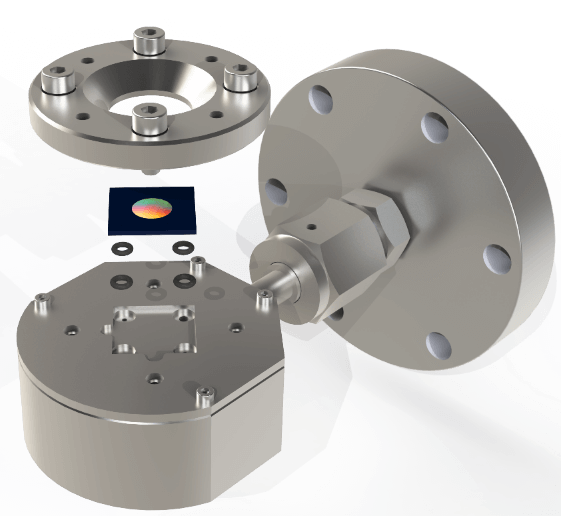
Figure 7. Image of a chip mounted in the interface block. The chip exchange is effortless and quick.
Third, the electron emission requires a few hours to stabilize each time the filament is powered up. Finally, pumping down a new chip via the main chamber would take too long to obtain proper chip evacuation.
Stability and control of these parameters are essential to enable reproducible and quantifiable EC-MS results. Our system avoids all this, ensuring fast and reliable operation and an extended lifetime. It also avoids the need for bake out, enabling rapid and reproducible chip and sample exchange without ever venting the chamber.
STREAMLINED SOFTWARE SOLUTION
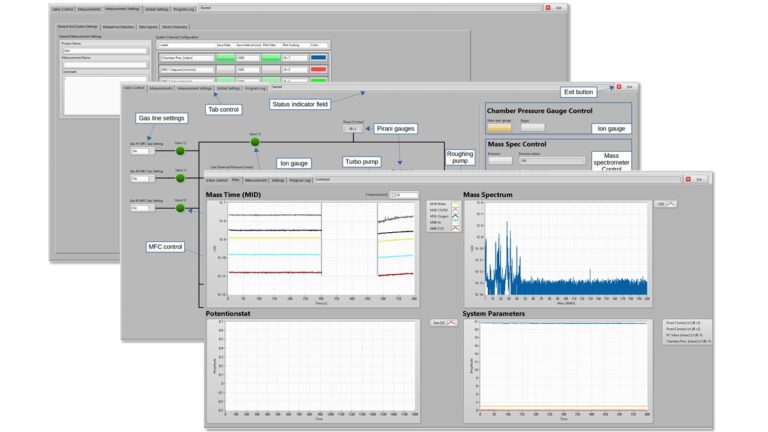
Screenshots from the user interface and a photograph of the software in action during a Pt cyclic voltammogram in acidic electrolyte.
We developed the Spectro Inlets EC-MS system in collaboration with Bio-Logic, so users can use the familiar EC-Lab software at its full capability to control EC experiments. The Spectro Inlets software directly communicates with EC-Lab and makes all the plots available inside the graphical user interface, together with the MS data.
The software allows the complete overview and control of the system with a user-friendly graphical user interface. Pneumatic valves, vacuum system, electronics, gas inlet system, and data acquisition are controlled via this interface. The user can manually control the individual components or use the convenient automated procedures, e.g., chip pump-down, timed gas pulsing, gas exchange, gas flow control, pressure control, etc.
The software streamlines synchronous acquisition, display, and storage of electrochemistry and mass spectrometry data with sub-second time resolution. The EC and MS data are acquired simultaneously, displayed side-by-side, and exported in a single ASCII text file, pre-synchronized. The file format is simple and well documented, helping with data analysis after experiments.
Automation enables the freedom to concentrate on electrochemistry and obtain reproducible, standardized results. The software is developed in LabView, and it is open source. Our users are free and encouraged to modify the software and tailor the interface to their needs.
